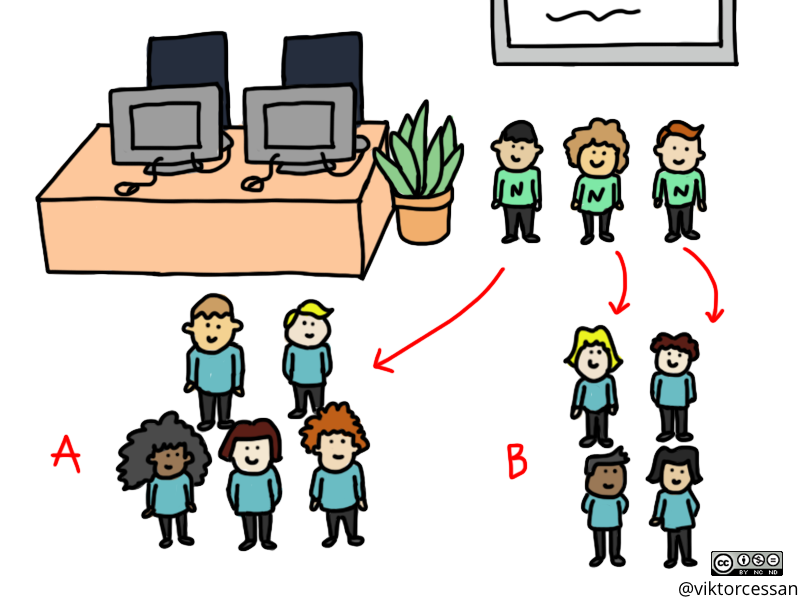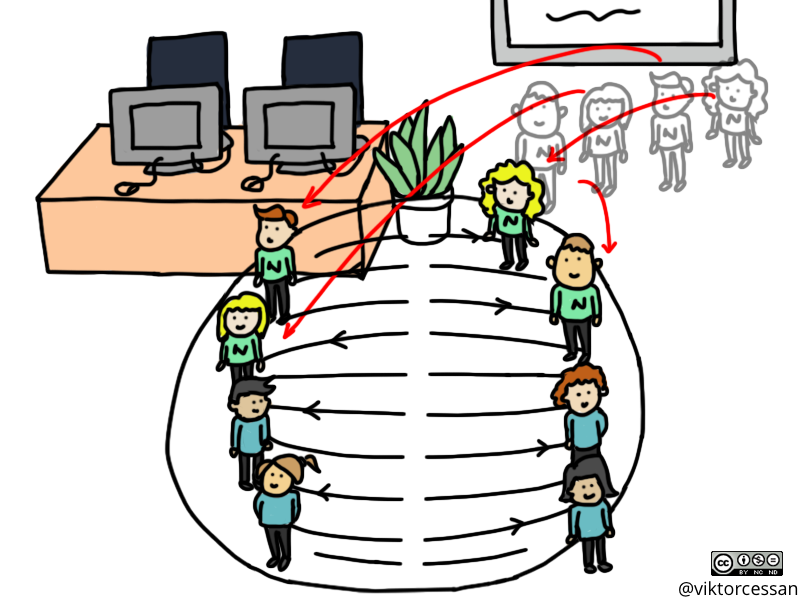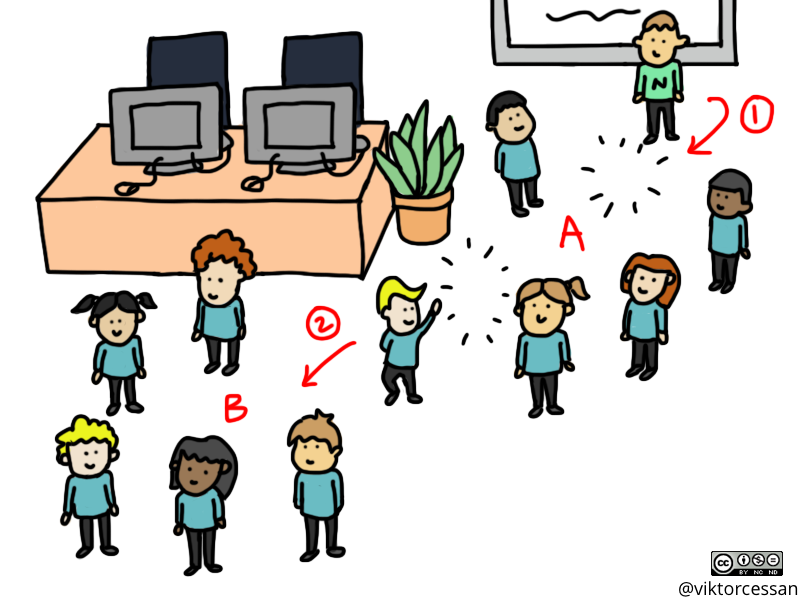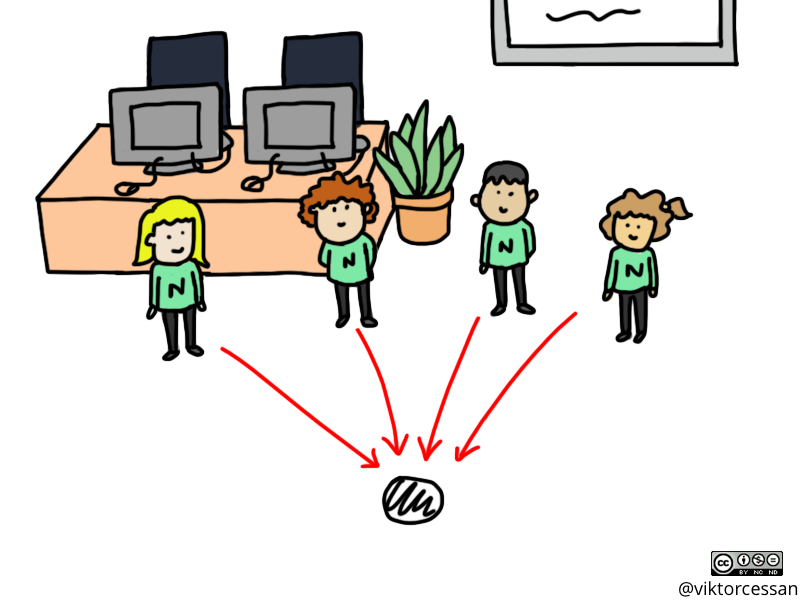Reading Time: 11 minutes
There’s lots of great material out there on how to build agile teams. That material focuses on support and improvement at a team level which is of course one crucial component. But in the midst of all this, we seem to have forgotten one of the most important aspects of team building that has a huge impact on team performance: the organizational growth strategy.
Don’t get me wrong: helping individual teams become high performing teams is essential (and there are enough pitfalls to avoid there as it is). But if you don’t consider your team growth plan, the way, and frequency with which you choose to grow your teams, you may be counteracting all the effort you’re putting into helping those teams become high performing.
Below I’ve listed the four most common organizational growth strategies that I’ve seen across companies and industries. I’ve written out the benefits, drawbacks, and some tips on what you can do to reduce the downsides for each approach. Because there’s no organizational growth strategy that only comes with upsides, the key, as with most things, is determining which downsides you’re able to work with.
Why does having an organizational growth strategy matter so much?
You may be thinking: “why do we need an explicit organizational growth strategy?” We’re human and flexible and can adapt, right?
Constant changes in team composition require time and energy to build psychological safety back up each time a team composition change is made. This often means that the benefits of your hard work at getting the agile process down right and helping the team learn how to work well together will be greatly reduced. All that makes it even harder to become a high performing team.
Why does psychological safety matter?
Psychological safety is a state in which team members feel safe taking interpersonal risks. William Kahn, a professor in organizational behavior at Boston University, did extensive research on the topic and describes psychological safety as “being able to show and employ one’s self without fear of negative consequences of self-image, status or career.”
The level of psychological safety we feel in a given situation influences which parts of our brains get activated. When our brains have determined that the environment is socially safe, we are able to use abstract thinking, language, memories, creativity, and empathy freely and in new ways. The opposite is true when the brain registers low social safety–we go into threat response mode which means fight, flight, or freeze.
Try solving a problem when one third of the team wants to get out of the room, one third has shut down their brains so they can’t even process what they are hearing, and one third is busy finding fault and being aggressive. You’ve probably seen it before–not exactly the best environment for productive collaboration, right?
Psychological safety is considered to be one of the most important enabling factors of high performance in teams, and the way you grow teams directly affects it. That makes having an explicit organizational growth strategy all the more important. So what are four ways you can grow teams? Let’s take a look, and we start with a strategy I call “Recruitment Whac-A-Mole” which is the most common organizational growth strategy companies have.
Recruitment Whac-A-Mole

You probably remember the arcade game Whac-A-Mole in which you use a mallet to “whack” plastic “moles” as they popped up, earning a point for each successful strike. Recruitment Whac-A-mole refers to the process of opening up positions in different teams and focusing intensely on filling those positions as they “pop up”. You’re probably quite familiar with it already as it’s the most common way to grow teams.
And that’s no surprise. It’s very straightforward after all. Here’s a recruitment need that’s popped up in a team, here’s an available person that meets their requirements and that the team approves. Boom, done.
During times of high growth, open positions pop up seemingly everywhere and in every team. That leads to a whole lot of mole whac-ing. As you may have guessed, Whac-A-Mole as an organizational growth strategy comes with the most significant drawbacks both short and long term. So why do companies default to this method of team growth?
The benefits
- Whac-A-Mole is rationally straightforward. We’ve become so accustomed to it that it’s now more or less an established industry best practice (from a recruitment perspective).
- It’s easy. Again, here’s a person, here’s a team. Boom, done.
- It scales well. And if you need to scale faster you can simply hire more recruiters and managers.
- It’s easy to match new hires with teams and challenges that match their interests and ambitions.
- As a new joiner, knowing which team you’ll join gives you a sense of the people in the team. This makes it possible to assess whether you want to work with the team or not. Psychological safety often goes up if you know who you’ll be working with.
- Of course, this works both ways. The team will also feel a sense of increased psychological safety since they know beforehand who will be joining them.
- In project-based organizations, Whac-A-Mole is often appreciated as it liberates Project Managers from stable structures that put deadlines at jeopardy (e.g., “our delivery date is in 3 months, so I can’t start recruiting externally now”).
The drawbacks
The downsides of this team growth approach are mainly related to the negative impact on psychological safety that frequent changes to team composition have, namely:
- Reduced cognitive ability/performance in all teams that are recruiting, every time they recruit.
- Teams shifts their focus from solving problems and reaching goals to building relationships and re-visiting processes, roles, structures, and purpose. (If you’re familiar with Tuckman’s stages of Group Development or Susan Wheelans IMGD what’s happening when you frequently change team composition is that the team moves back and forth between Storming/Counterdependency and Fight.)
- Subgroups can form as new joiners may be threatening to the social status and have different opinions about the purpose. And let’s face it: if you’ve worked in a team that’s run roles and responsibilities workshops 5 times in the last 5 months you’ve probably gotten really tired of it.
- Team members start thinking about leaving (and actually leave) the team to find a team where there’s peace and quiet so that they can focus on their direct work.
- Companies mobilize themselves to deal with interpersonal conflicts and re-integrate sub-groups that work in isolation. And if you’re organization is scaling rapidly, there are even more situations a company needs to deal with. So that’s company energy spent on dealing with conflict and not with reaching goals.
Countermeasures
If you’re stuck in a Whac-A-Mole team growth system, here are some things you can do that will help you reduce the drawbacks mentioned above:
- Have a conversation with the team and ask them what effects Whac-A-Mole is having on their happiness, productivity, and stress levels.
- If you know you’re going into a Whac-A-Mole period, make your decision-making process as well as prioritization process explicit. It’s easier the smaller your team is and more stable it’s been. So you might not get a better chance than before you start recruiting.
- Actively and often show appreciation towards each other and celebrate. As a product manager, you can immensely help the team with this by prioritizing small tasks that are easy for the team to accomplish. This creates a positive atmosphere which increases psychological safety.
- Make sure every new hire has a buddy for an extended time and preferably rotate that person.
- Mob program for an extended period of time whenever someone new joins. It’s a great way to get to know someone, knowledge share, and integrate someone. Don’t get me wrong, I’m a huge fan of mob programming and I know not everyone is, but mob programming is a great onboarding strategy especially when there is frequent changes to the team composition. It becomes a stabilizing ceremony.
- Create structured knowledge sharing.
- Batch people in (rather have 3 people joining the same week than one per month to make it possible to run bootstrap exercises etc
- Create an onboarding program that’s owned by the team.
Mitosis Is Another Organizational Growth Strategy

This strategy gets its name from the biological process of mitosis which is how cells divide. It starts with one stable cell growing in mass until it has the size to divide into two replicas (two stable cells). When mitosis happens at a sustainable rate, it causes minimal disruption.
In terms of team growth, this means:
- Build a large team. High performance is optional but some level of psychological safety is mandatory.
- Add lots of people to the team in a short period of time. The short period of time (1-3 months) is key otherwise, this is just Whac-A-Mole in disguise.
- When the team has doubled or tripled in size, split the team into naturally formed sub-groups or run a self-selection event. There needs to be some level of stability before you split the team in order for the new groups to not be selected as a flight response.
I’ve helped facilitate several splits using the Mitosis approach as an organizational growth strategy. The most recent one was splitting a huge value stream to independent streams that had value to the customers but the organization didn’t know how to. We merged several teams, and, after they’d been exposed to the entire value stream for some time, we asked the teams and team members themselves how they thought they should be split.
The benefits
- It’s a fairly simple way to grow teams: just push everyone into the same team and ask them to identify independent customer needs to organize around.
- As the team grows, tension will often arise. Since everyone knows that a split is around the corner (weeks to a month or two away), it increases their patience and willingness to collaborate with each other since they know it’s a time-boxed, short-term phase.
- You may be able to get by without spending too much time on full team retrospectives and continuous improvement activities since teams know a new structure is coming and can tap into short-term patience. Not having to participate in retros with 10-15 other people you don’t know well or that you know you may not work with in a months time reduces tension and frustration.
- You focus growth efforts on certain areas and teams which reduces the negative impacts that scaling has. Since the other teams are stable and have time to improve their collaboration as a result.
The drawbacks
- Doubling or tripling team size in a short amount of time reduces psychological safety significantly.
- Approaching team growth in this way may completely stall the team’s ability to perform, and it may even cause mental health issues if interpersonal conflicts arise that aren’t dealt with or if there aren’t structures in place that create safety.
- Growing many teams slowly to eventually conduct a mitosis split causes all the drawbacks with Whac-A-Mole as well as with Mitosis. (So pick one).
- The sub-groups that naturally form when a team grows above five members may be based on biases and identity such as tenure, language, ethnicity, style of working, or role rather than what’s best for collaboration. The longer it takes before adding new members, the stronger these sub-groups will be.
Countermeasures
- Set the split date in advance so that everyone knows when it will happen and through self-selection.
- When the team gets big (10+), have a conversation with the team about when you’ll meet in a large group setting, what you’ll talk about, and how you’ll make decisions. Meeting to make decisions with 20 people can be tricky so it’s best to have a plan.
- Build relationships through formal and informal settings e.g. demos, knowledge sharing sessions, social events etc.
- Together with the original team members, talk about your organizational growth strategy before taking in more members. Set up a rotating collaboration program like pair programming or mob programming so that when the first person joins it becomes the norm from start.
- As early as possible make your decision-making process as well as prioritization process explicit.
Next Up We Have Team Progression

This is another organizational growth strategy. In times of hyperscaling this adds unnecessary tension but if your organization is growing slowly and organically this may create the internal movement you need to unleash creativity and knowledge sharing that bumps up everyones game.
Team Progression works as follows: new hires (always or often) start in one and the same team (A). Whenever someone joins that team, someone leaves that team to team B and someone from team B leaves for team C. Deciding who moves once someone new joins can be decided through a pre-defined process or on a case-by-case basis. Both require different preparations.
The benefits
- This organizational growth strategy provides a structured approach to internal movement and over time spreads knowledge of teams, customers, and technology. This helps build an informal network and improves feedback loops over time.
- If this is based on volunteering, the person moving often gets an increased sense of purpose and motivation which can energize the team they’re joining.
- If you have some level of predictability and a reasonable rate of growth, you can coach and train your team’s abilities to integrate new hires better. Such practices include making the internal mobility process explicit, creating a culture of frequent appreciation and celebration, and creating structures around knowledge sharing such as mob programming, getting a buddy, weekly show and tell, etc. (though these structures are valuable regardless).
The drawbacks
- Instead of just affecting the dynamics of one team, one person joining the company affects the team dynamics of *all* teams. Sometimes for the better, but also for the worse (at least temporarily). That is especially true if you haven’t actively worked with improving the team’s ability to integrate new team members which again reduces psychological safety.
- If you don’t actively and effectively work with knowledge transfer and collective ownership of code, a person leaving a team may create a new dependency.. For example, she may have specific knowledge about features or may even be responsible for features or applications. If the team member brings the ownership with her to the new team, she’d dilute the different teams missions and will not be able to fully focus on the new mission. Neither case scales.
- You may want or need to get managers or HR involved in defining the rules around career progression to ensure that it’s objective/fair and isn’t only based on the manager’s own discretion. So, more time spent in meetings.
Countermeasures
- Facilitate relationship building between different teams through both formal and informal ceremonies.
- Actively work to reduce personal dependencies by inventorying people’s skills and knowledge sharing around critical knowledge or systems.
- Make your decision-making process as well as the prioritization process explicit as early as possible. If you reuse them between teams, transitioning becomes easier (though be aware of potential downsides if you do decide to centralize this aspect).
Build New Teams With New Hires

Rounding out the list is an organizational growth strategy I haven’t seen used widely but I find quite interesting and that’s worked for me in the few instances I been a part of it.
When I was a consultant at Avanza Bank in Sweden, they ran an experiment with a different approach to team growth: building entirely new teams with new joiners and have trial runs with trainees. The trainee teams received whatever support they needed in terms of coaching, facilitation, and mentoring. To some extent, this may resemble how some tech companies run bootcamps, but there are some meaningful differences: the length of time that the team stays together, for example, which in bootcamps can change from month to month as new hires get to explore new aspects of the company.
The benefits
- Your organizational growth strategy does not affect multiple teams’ performance, dynamics, and psychological safety. Even if you do bring in people from other teams to embed for a short period of time, they’re not a part of the new team (but are instead temporary alliances), they don’t need to be in all meetings, and they don’t affect the social dynamics as much as if they were in the team. So the new and other existing teams can evolve their team dynamics mainly unaffected by each other.
- Knowledge sharing and collaboration happens organically because team members are new to the context and knowledge so they all have an interest in bridging knowledge gaps. This is highly visible in bootcamps in which the team members communicate and collaborate often (in the beginning).
- Increased collaboration increases people’s sense of purpose and motivation.
- There’s little to no pre-existing status to consider. Because the team members need each other, they’ll have to learn how to deal with their differences.
- Other teams, thanks to increased team stability, experience high levels of psychological safety which reduces inter-team conflicts and improves the company’s ability to solve complex problems and collaborate.
The drawbacks
- There are lots of upfront costs with this organizational growth strategy. During the first few months, it may appear as if the new team is fumbling around as they’re trying to get up to speed–it takes time until the team is able to deliver substantial value.
- All new hires need to start within a few weeks of each other which may not be popular with HR or Management because it makes their life harder.
- This may mean that HR needs to re-think how they evaluate themselves from speed of hiring or cycle time per hire to speed of building happy and productive teams.
- New teams may be considered second class teams that don’t get the help they need from more established teams. You’ll need to actively work on building relationships and setting up knowledge sharing between teams to counteract that.
- Newer teams may get the “boring stuff” from other teams or not have the mandate as a result of other teams not trusting them. Motivation and sense of purpose could therefore suffer. Again, to counteract this, you’ll need to focus on building relationships and setting up regular knowledge sharing programs or mentorships.
Countermeasures
- Plan which other teams and team members will support this newly-formed team. It’s great if you know what the new teams mission will be so that you can find relevant support from relevant teams.
- Assign a junior product manager to this new team. A study done at Rotterdam School of Management found that junior team members feel safer to challenge the ideas of junior managers. Read more here.
- Focus on early wins give the team bite-sized pieces of work that they can handle. Whoever is product manager needs to be willing to direct the team early on and slowly start sharing the ownership.
- Make your decision-making process as well as prioritization process explicit as early as possible.
- Arrange for all team members to sit next to each other in a collaborative environment (unless they’re a remote team). If possible, create a mob programming station in their team area to help them learn things together in the beginning (they’re going to need to).
Organizational Growth Strategy Take Aways
I've walked through a lot in this post, so I want to sum up my main takeaways (or the TL;DR for those of you who may have skimmed)
- Different organizational growth strategies have different costs associated with them. To maximize the gain and reduce the costs, you must preemptively devise strategies that counteract the downsides associated with your approach to growing teams.
- Not paying attention to your team growth strategy has a negative impact on team dynamics, performance, and motivation.
- By involving the team in devising strategies, you’ll get collective ownership and also increase awareness.
- What’s common in counteracting the negative effects is facilitating building relationships, knowledge sharing, and agreeing on how to makes decisions while team composition changes.
Is your company or organization currently scaling or planning to scale? You may be interested in my public training course Mastering Team Dynamics if so. It builds upon Bruce Tuckman's and Susan Wheelans research but has been adapted for knowledge work in a complex and rapidly changing environment and you’ll learn how to faster coach teams to high performance.
As always, leave a comment, send me an email, or Tweet at me and share your thoughts.
3 Comments
Allison
I love the name “Recruitment Whac-a-Mole”–I’ve seen that too often! You are right about the need for psychological safety, and I learned a lot from Heidi Helfand’s talk on Dynamic Reteaming — http://www.heidihelfand.com/dynamic-reteaming/ Good food for thought when it comes to organizational growth. :)
Pingback:
Jason Cameron
Great read, I particularly like the common countermeasures which regardless of strategy are a good starting point to enhance team dynamics. Cheers :)